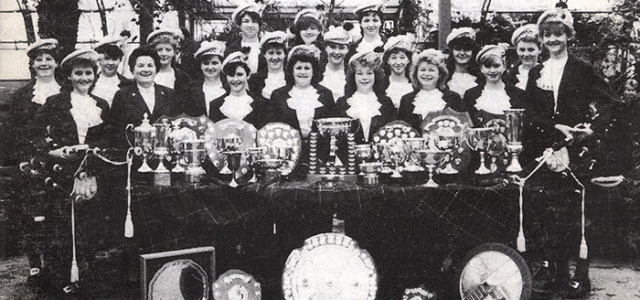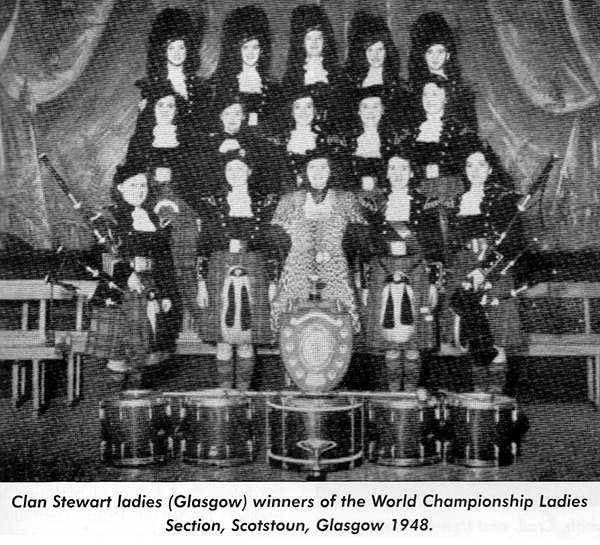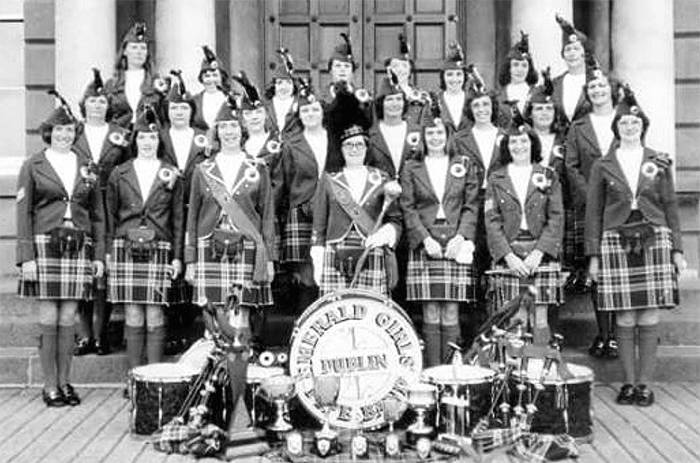
By Jeannie Campbell
It is interesting to note that in the days before the advent of the ladies’ pipe band most lady solo piping competitors were pictured wearing a tartan skirt with dark stockings.
The subject of dress and whether ladies should play at all has caused controversy over the years.
In 1938 Mr Thomas Reid, a member of the Canadian Parliament, wrote that ‘Although women may become efficient mistresses of the bagpipes, in so doing they are losing their natural feminine charm.
‘Most women pipers looked knocked out of shape, their bodies acquiring an unnatural twist trom strenuous blowing. Men are preserving tradition by playing the pipes and wearing kilts.
[wds id=”2″]
‘Women should do their part by wearing their original dress of Tam O’Shanter, blouse and plaid skirt, and leave the costume of kilt, sporran, dirk and plaid to the Highland lad.
‘The bone of contention regarding the right of women pipers to compete with men arises mainly from the Scottish lass usurping the male attire and the fact that in mixed contests chivalry is displayed by judges in slight favouritism toward women pipers.
‘Pipers generally are jealous musicians. They feel keenly when out-classed by another piper and it is not soothing to their pride to take a back seat to a woman.’
During the summer of 1939 the boys of the Greystone Rover Pipe Band from Eire visited Scotland. While in camp at Crieff they met two girls, a piper and a drummer from a girls’ band in Glasgow.

The boys persuaded the girl piper to play one of their bagpipes and were greatly impressed by her ability. Unfortunately her name was not recorded.
At the Scottish Pipers’ Association Amateur/Juvenile Competition in April 1939 the prize for the Best Dressed Piper and Most Correct Juvenile Marcher went to Miss Nan Stevenson from Coatbridge. She was to appear later as P/M of the Caledonia Ladies’ Band.
In January 1939 the editor of the ‘Piping and Dancing’ magazine commented on the growth of the girls’ pipe band movement in Ireland, saying there were now two girls’ pipe bands in Dublin.
He went on to say that in the past three months he had been informed of the formation of girls’ pipe bands in many places, in Canada especially, while in Scotland the movement seemed to be confined to the three bands which had been in existence in Lanarkshire for a few years past.
In September 1939 the reporter from ‘Piping and Dancing’ made a visit to the headquarters of the City of Dublin Girls’ Pipe Band and met their instructor Sean Lawless who told him about the band’s recent visit to the National Folk Dancing Festival in Berlin [This in the Nazi era].
They had a very enjoyable but rather strenuous time as each day was mapped out for them with typical German military precision, every hour of the day being accounted for.
They had to give band parades at several places each day at times set down in the programme handed to them each morning, all at fixed hours till late at night and sometimes running into the early hours of the morning but they got a great reception from the German people to whom a girls’ pipe band was a novelty.
The band had twelve playing pipers and over 30 others, all keen workers. The reporter finished with this statement, ‘Miss Nancy Delaney is the Lady Pipe Major. She has a fine figure, looks the part and can do the job cleverly and very gracefully.’
The other Dublin Band was the Emerald Girls’ Pipe Band (below), which was founded on 6th June 1939. Less than two years later, on 17th March 1941, they made their first public appearance at the St Patrick’s Week show in the Queen’s Theatre, Dublin.

The Pipe Major at that time was Miss Vera McCullough. The girls travelled all over Ireland, visited Edinburgh in 1948, and visited London twice.
They were selected to represent Ireland at the 3rd International Festival of Pipe Bands in Brest, Brittany in 1955 and at the International Festival of Music in Angiers, France in 1956.
Their uniform consisted of a green tunic and a specially designed kilt of green and gold tartan with emerald green stockings and black shoes.
The band made history at Belfast in 1956 when they became the first non-Scottish band to win a World Championship.
Pipe Major Joan Lynch was in charge, assisted by Pipe Sgt. Angela William, Pipe Corporal Annie McKenna and Drum Sgt. Agnes O’Connor. The band was still competing in the 1970s.
- To be continued. Read the first instalment of Miss Campbell’s history here. The picture up top is of Deeside Ladies Pipe Band, Aberdeen, circa 1987.
[wds id=”8″]















